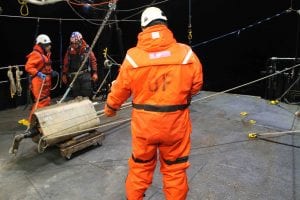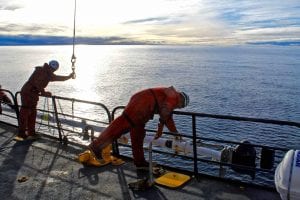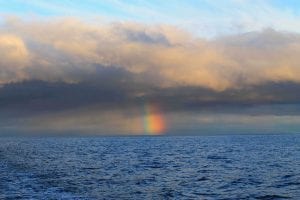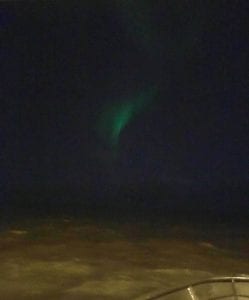Sunday, September 18, 2016
Halfway Point and Northern Lights!
By Madie Jones (Master’s student, SMU)
Well, we’re officially past our halfway point as it is day 7 aboard the Norseman II. Only three full science days left until we head back to Alaska to end our time at sea. We’ve been working around the clock to collect heat flow and chirp data along 3 transects, labeled in red on the map below. The yellow lines on the map are the track lines of airgun seismic data collected by the USGS in 1977. We’re using some of the USGS seismic lines to help make sense of what we see in the heat flow data.

We started on the transect farthest to the East (BHF 1, 2, 3), and worked our way West to BHF 4 and BHF 5 (BHF stands for Beaufort Heat Flow). The first line took the longest, but once the crew and scientists started to get into a routine, we worked very efficiently through the last two lines. So far we’ve collected 60 heat flow data points and 100 km of chirp seismic data!
We’ve been working literally around the clock. Dr. Hornbach and Dr. Harris are on 12-hour rotations. Casey, Ben and I are set to work 8-hour rotations. That way there is always at least 1 chief scientist and 1 graduate student or postdoc working every hour of the day. That also means heat flow probe deployments and recoveries can happen in the middle of the night when it’s pitch black outside and you can’t see past 5 feet from the boat.

Dr. Hornbach, Dr. Harris and Dr. Phrampus are starting to make some really interesting interpretations of the patterns they’re seeing in the heat flow data. I’m pretty new to the world of gas methane hydrates and heat flow but I’ve learned so much listening to them brainstorm and talk about what could be happening in the subsurface to explain what is seen in the data. This is the first heat flow study of the Beaufort Sea, so the data we’re collecting has not existed before now.

Today a storm rolled in, creating 14-foot swells and nearly 40 mph winds. Our 115-foot ship is currently heaved-to in a bay until the storm passes over. To give you some perspective, it becomes very difficult to walk around the ship, much less deploy the heat flow probe, with 5’ swells. I can’t even process what it would be like trying to stand up or walk around the boat or deploy a heat flow probe in 14’ swells.
We’re scheduled to get back out tonight after the storm passes for at least one more transect before our time at sea runs out. In the meantime, the scientists have started analyzing data, making maps, creating figures and getting a head start on writing Arctic heat flow papers.
Even with everything in full swing aboard the Norseman II, I’ve managed to find some time to take some pictures of the scenery out here.


And…. tonight I got to cross an item off my bucket list. My 8-hour shift starts at 8pm and ends at 4am. So I’ve been up and working through the night, every night for the last week. Tonight around 3:30am, the science lab got a call from the ship’s first mate, Wayne, to let us know the northern lights were out and pretty strong. We hustled up to the bridge to watch the show. Words really can’t describe but for about 30 minutes we watched the green and red and white lights streak across the sky. I tried to take a picture with my phone, but as you could imagine the picture doesn’t even come close to doing it justice. While we were up in the bridge with Wayne he told us that the lights only come out like this once every couple of months.

I’m looking forward to getting back out to sea tonight to continue collecting heat flow data. I’ve already learned so much from the other scientists and I’ll be taking many things away from this experience. I’m feeling very lucky tonight to get to be a part of this cruise. More updates to come!
You can see where the Norseman II is by clicking here.
Great post! Thank you very much for this information with us.